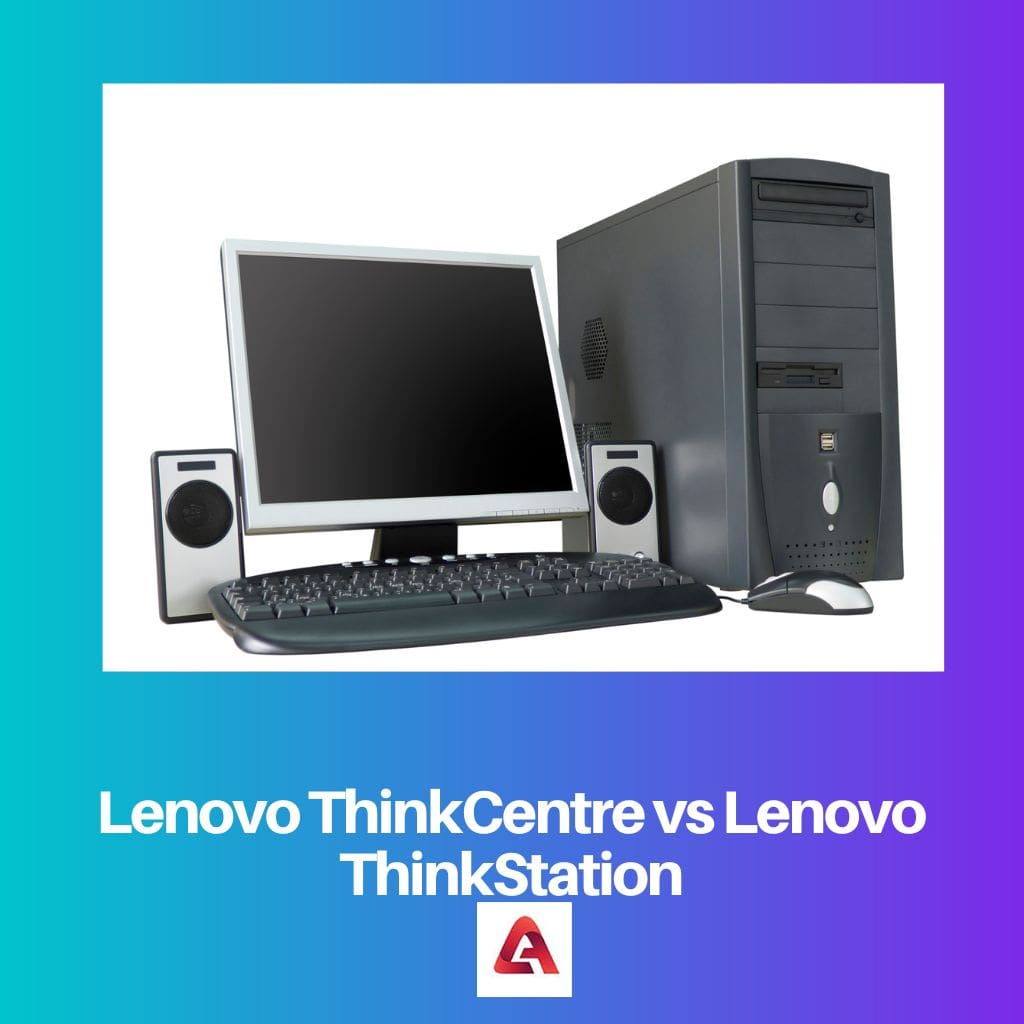Lenovo ThinkCentre and Lenovo ThinkStation are two different lines of high-end computing devices offered by Lenovo. ThinkCentre was launched in 2003 by IBM and was continued by Lenovo after its acquisition of IBM’s personal computing business in 2005. ThinkStation was launched by Lenovo in 2008.
Key Takeaways
- Lenovo ThinkCentre computers are business-oriented desktops focusing on reliability, security, and manageability.
- Lenovo ThinkStation workstations provide high-performance computing for professional applications such as CAD, video editing, and scientific research.
- Both Lenovo ThinkCentre and ThinkStation computers are designed for professional use, with ThinkStation offering more power for demanding tasks.

Lenovo ThinkCentre vs Lenovo ThinkStation
ThinkCentre was launched by IBM. It was launched in 2003. It is a type of desktop computer. It can be used for personal work or office work. It can support the MS Windows operating system. Thinkstation was launched by Lenovo. It was launched in 2008. It is a type of workstation. It is expensive as compared to the centre. It can support most of the operating systems.
Lenovo ThinkCentre is a series of desktop computers which can be used for home or office use. They can be seamlessly used for everyday activities like web surfing, emails, organizing photos etc. They are also great gaming devices due to their fast processors, graphics card and a lot of storage space.
Lenovo ThinkStation systems are ISV certified, energy-efficient and very powerful. They are extensively tested for compatibility and reliability in DCC (digital content creation) and CAD (computer-aided design) environments. However, they can also be used for typical office use as well. These are highly versatile systems and can also support gaming facilities.
Comparison Table
| Parameters of Comparison | Lenovo ThinkCentre | Lenovo ThinkStation |
|---|---|---|
| Origins and launch | Launched by IBM in 2003. Later acquired by Lenovo in 2005. | Launched by Lenovo in 2008 |
| Type | Desktop computers | Workstations |
| Usage | Can be used for both office and personal use | More suitable for high-end professional use like CAD and DCC environments |
| Amazon Price | Starts at around 100 USD | Starts at around 900 USD |
| Operating Systems | Most models support MS Windows | Most models also support Linux Ubuntu/Red Hat OS alongside MS Windows |
What is Lenovo ThinkCentre?
The Lenovo ThinkCentre series was first developed by IBM in 2003. After its takeover of IBM’s Personal Computing Division (PCD) in 2005, Lenovo has been responsible for designing, developing and marketing the ThinkCentre series.
These are business-oriented desktop computers which are compact, stable and easy to use. They are designed to boost productivity while saving much-needed desk space in corporate environments. They also have advanced security features. These make them suitable for corporate rollouts. They can be easily configured and expanded per the needs of the business.
ThinkCentre computers are equipped with mid-range to high-end processors. They also provide options for discrete graphics cards and multi-monitor support. They can be used for both office and personal use.
The major product series within the ThinkCentre line are the A-Series, M-Series and Edge Series. The latest in line is the ThinkCentre™ neo desktop portfolio. ThinkCentre Neo 50a 24 was launched in July 2022 as part of this portfolio. According to a press release by Lenovo, it supports 12th Gen Intel® Core™ i7 H-series Processors as well as the latest Windows 11 operating systems. It is an all-in-one (AIO) desktop with innovative A1-assisted features. It aims to meet Small and Medium Businesses (SMBs) requirements.

No products found.
What is Lenovo ThinkStation?
Lenovo ThinkStation computers are powerful workstations that have been thoroughly tested to run even the most demanding applications. They are certified by ISV (Independent Software Vendors). This ensures that the certified systems can support the most critical applications per the demands of your business or industry.
ThinkStation workstations are compatible with the latest generation of Intel® Xeon® processors and NVIDIA® Quadro® professional graphics in dual- and single-processor systems. They are energy-efficient and offer superior reliability.
A variety of industries/professionals can use these workstations. They are designed for architects, designers, financial traders, medical professionals, engineers etc. They are high-performing, easy to use and provide dependable and powerful processing capabilities. They have a modular design, due to which making upgrades and customizations is effortless. They also support a large number of possible configurations.
First launched in 2008, the latest series in this line is the P360 series which was launched in 2022. The P360 Tiny boasts of being the smallest workstation available in the industry at a total volume of less than one litre. It is equipped with the 12th Gen Intel® Core™ processors and supports the latest Windows 11 and Ubuntu Linux operating systems. It is also eco-certified and built with sustainable materials.

Main Differences Between Lenovo ThinkCentre and Lenovo ThinkStation
- Lenovo ThinkCentre was originally a product of IBM which was later acquired by Lenovo in 2005, whereas Lenovo ThinkStation was launched by Lenovo in 2008.
- Lenovo ThinkCentre is a line of desktop computers, whereas Lenovo ThinkStation is a line of workstations.
- Lenovo ThinkCentre is suited for both business and personal use, whereas Lenovo ThinkStation is more powerfully built to support high-end computing with CAD/DCC tasks.
- Models of Lenovo ThinkCentre can be found at around $100 on Amazon, whereas Lenovo ThinkStation models are more expensive, with prices starting at around $900. Regarding both of them, most of the models on Amazon are available without major I/O devices like monitors, mice, keyboards etc. Thus, the same needs to be considered before making a buying decision.
- Most models of the Lenovo ThinkCentre series only support Microsoft Windows operating systems, whereas the Lenovo ThinkStation series has models that also support Ubuntu Linux or Red Hat Linux operating systems.